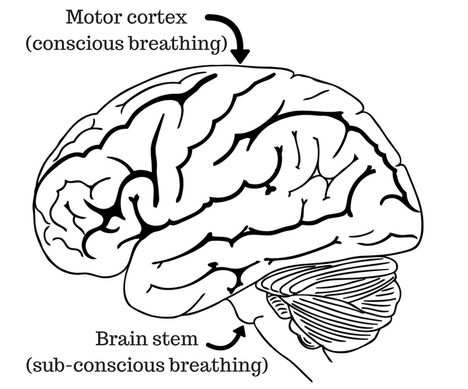|
Most of us know that our breath functions automatically most of the time. This function---breathing without thinking---is controlled by the autonomic nervous system in one of the oldest parts of our brain: the brain stem, located at the base, where the spinal chord turns into the brain.
Most of us also know that we can control our breath consciously, choosing the speed at which we breathe and even stopping it altogether, for a short while at least. This conscious control of our breath is done by the somatic nervous system, the part that controls voluntary functions like walking, writing or playing baseball. It is located on the surface of the brain at the very back of the frontal lobe, in a place called the motor cortex. Whenever we consciously control our breathing, the motor cortex overrides the brain stem. This process takes a lot of effort from the brain, which is why it has the effect of focusing us. As an experiment, try to control your breath while doing a math problem in your head. It is difficult. When we consciously control the breath, the brain becomes still. This phenomenon is one of the key principles of pranayama (breath control) and even the most simple breathing exercises. Even for a true beginner, counting the breath or trying to control it at all calms the mind and leaves them feeling very focused.
1 Comment
HTX_Yogi
3/10/2020 10:20:34 am
Love this simple explanation.
Reply
Leave a Reply. |
AUTHORSScott & Ida are Yoga Acharyas (Masters of Yoga). They are scholars as well as practitioners of yogic postures, breath control and meditation. They are the head teachers of Ghosh Yoga.
POPULAR- The 113 Postures of Ghosh Yoga
- Make the Hamstrings Strong, Not Long - Understanding Chair Posture - Lock the Knee History - It Doesn't Matter If Your Head Is On Your Knee - Bow Pose (Dhanurasana) - 5 Reasons To Backbend - Origins of Standing Bow - The Traditional Yoga In Bikram's Class - What About the Women?! - Through Bishnu's Eyes - Why Teaching Is Not a Personal Practice Categories
All
Archives
May 2024
|







 RSS Feed
RSS Feed